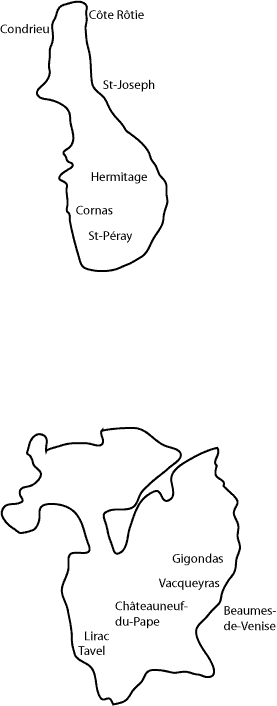
Rhone Valley
 Overview
Overview
This region of France was only known by the most serious wine lovers until the early 1980s. An explosion of popularity led to enormous price increases as demand grew. Unquestionably wines of great quality originate in this region; however of late too many poor examples seem to be available.
Warm to hot in the South, the Northern Rhone is cooled by the Rhone River and the steep hillside vineyards. None steeper or more spectacular than those of the Cote Rotie. The famed Mistral winds also play a role in reducing spring frosts and keeping the climate cool and dry.
Grapes
In the North Syrah rules, sometimes tempered by the fragrant white grape Viognier. Further to the south, as the temperature rises, Grenache takes on an increasing importance.
The White grapes are primarily Marsanne, along with Roussanne in the better wines.
Chateauneuf de Pape allows 18 varieties, reds and whites, to be blended to make this often exquisite wine. Chief among these are the red Grenache and the red wine grape Mouvedre.
Sub Regions
The Rhone Valley is long and wide. To even touch briefly on each village would be too much for this primer, so I will try to pick out the more important areas North to South.
Cote Rotie - This northern most region is made from Syrah with the occasional touch of Viognier for elegance. There are 2 parts of the Cote Rotie, the Cotes Blonde and Brune. It is said that they are named after 2 daughters, and that the slopes retain the characteristics of these daughters. All poetry aside, it is common for the two slopes to be blended together as Blonde et Brune.
Condrieu - Home of Viognier. The white wines from this area on the next hill down river from Cote Rotie can at their best be full of perfume and tart complexity. At their worst (too often Ch. Grillet, the most famous Condrieu) they are oxidized and lacking any flavor or charm, but selling for outrageous prices.
St-Joseph - Syrah with a touch of the white grape Marsanne on occasion, this wine is often as good (bad?) as its kin Crozes-Hermitage. Oddly this wine is made from a group of noncontiguous vineyards running for miles down the valley. A small amount of decent white wine is also made.
Hermitage - In the running with Cote Rotie as the best red wines of the Rhone. The Syrah grape as usual may have a small amount of white wine added to it. Rich and flavorful this is everything a great Syrah can be. Prices are often better than Cote Rotie, but it is wise to look for an older vintage when you can. The Whites can be exceptional and again are made from Marsanne and with luck a percentage of Roussanne as well.
Crozes-Hermitage - A huge area on the hills that surround Hermitage. Referred to as the poor man's Hermitage, this is a disfavor, to Hermitage. The wines of Crozes, and the similar wines of St-Joseph are too often light, almost beaujolais in style. When made with more traditional methods the Syrah of the region can be elegant and flavorful, while still enjoyable young.
Cornas - Richer and almost always better than Crozes or St-Joseph, this is the wine to look for if you want Syrah without the cost of Hermitage or Cote Rotie. Given proper time to age, this wine can yield remarkable results.
Saint-Peray - Great White wines when you can find them.
Chateauneuf du Pape - One of the most famous wine names in France. Due in large part because of the wine labeling revolution that started here and later became the basis of the Appelation Controlee system. CdP still leads in the labeling front, allowing only Estate Grown wines to bear the glass embossed seal of the town on their bottles. High in alcohol and easy to enjoy, this remains the best known of the Rhone wines.
Tavel/Lirac - The great Grenache based Rose wines that so few other Roses have ever matched. Never expensive and best enjoyed as young as possible.
Gigondas - Grenache with a minimum of 15% Syrah and/or Mouvedre as well as a little of the 11 other allowed Cotes du Rhone varieties. Considered a 'Super Cotes du Rhone' it was the first of the Cotes du Rhone Villages to be elevated to AC status. Some good to very good, but never great red wines can be found from this village.
Cotes du Rhone / Cotes du Rhone-Village - Blended wines , not only of the14 grape allowed grape varieties, Grenache being chief among them, but blended from village to village as well. Of varying quality, they are best when made by the traditional barrel fermented techniques and not the newer carbonic maceration technique (which is how Beaujolais is made, and why everything made this way tastes like Beaujolais).
Label Info
Armed with the above regions and an idea of the price, you can get a good idea of what is in the bottle. Price as always is the determining factor. Beaujolaised wines (made in the style of Beaujolais - my own term) are the cheapest and the most common. The white wines, being more rare than many of the reds, often fetch the highest prices.
Copyright WineEducation.com
Do not reprint without permission